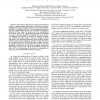Free Online Productivity Tools
i2Speak
i2Symbol
i2OCR
iTex2Img
iWeb2Print
iWeb2Shot
i2Type
iPdf2Split
iPdf2Merge
i2Bopomofo
i2Arabic
i2Style
i2Image
i2PDF
iLatex2Rtf
Sci2ools
PERCOM
2011
ACM
2011
ACM
Ranges of human mobility in Los Angeles and New York
—The advent of ubiquitous, mobile, personal devices creates an unprecedented opportunity to improve our understanding of human movement. In this work, we study human mobility in Los Angeles and New York by analyzing anonymous records of approximate locations of cell phones belonging to residents of those cities. We examine two data sets gathered six months apart, each representing hundreds of thousands of people, containing hundreds of millions of location events, and spanning two months of activity. We present, compare, and validate the daily range of travel for people in these populations. Our findings include that human mobility changes with the seasons: both Angelenos and New Yorkers travel less in the winter, with New Yorkers showing a greater decrease in mobility during the cold months. We also show that text messaging activity does not by itself accurately characterize daily range, whereas voice calling alone suffices. Finally, we show that our methodology is accurate by com...
| Added | 22 Aug 2011 |
| Updated | 22 Aug 2011 |
| Type | Journal |
| Year | 2011 |
| Where | PERCOM |
| Authors | Sibren Isaacman, Richard Becker, Ramón Cáceres, Stephen G. Kobourov, Margaret Martonosi, James Rowland, Alexander Varshavsky |
Comments (0)

